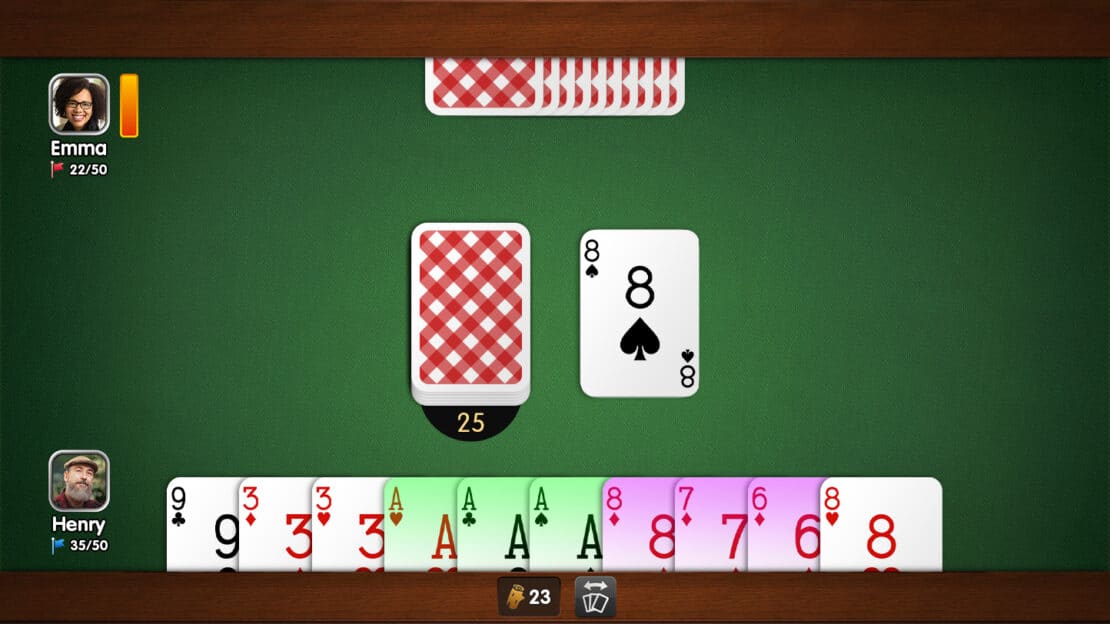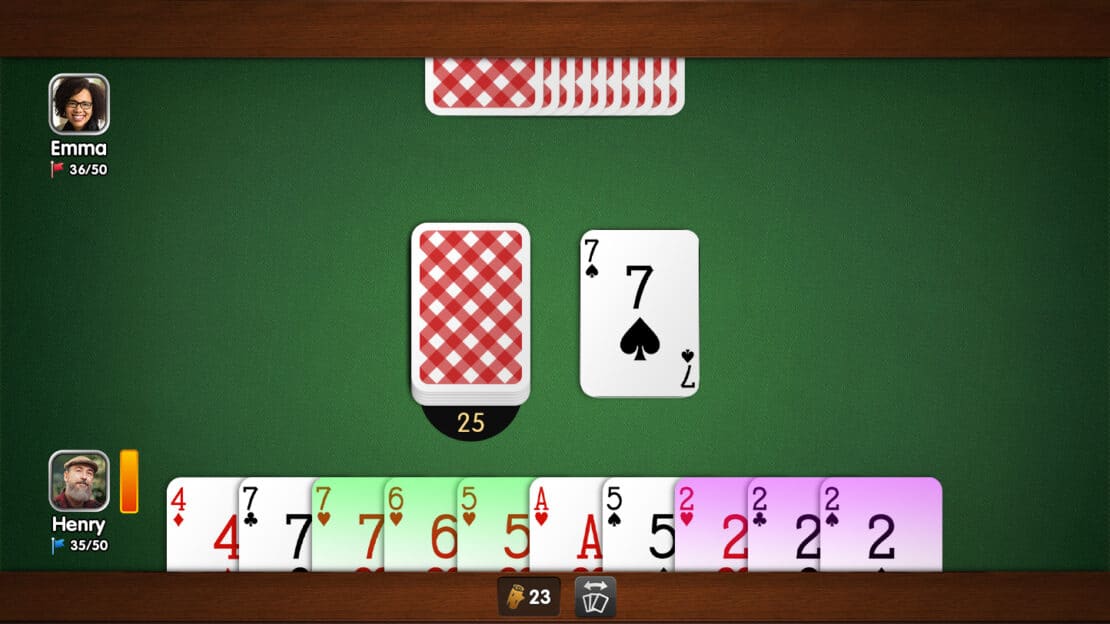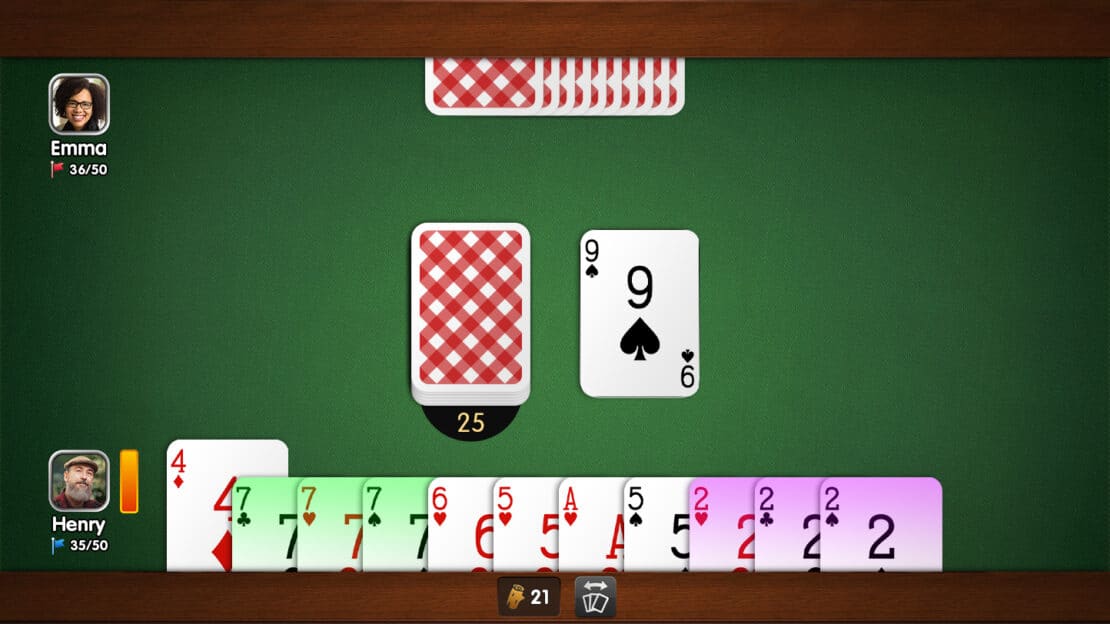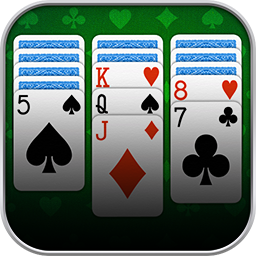Following the lesson about offensive gameplay, this lesson deals with another approach to Gin Rummy, the defensive style of play. If you are aware of both, it will be easier for you to determine your Gin Rummy maneuvers.
When playing Gin Rummy defensively, you give your opponent as few opportunities as possible to form or extend melds, which would ultimately help them reach a Gin.
Meanwhile, you are also working on combining your cards into melds in order to knock, of course. A Gin is not the main goal here; sabotaging the opponent takes priority.
This approach is a fairly reliable source of low losses and high winnings, which is why it is more promising in the long run than exclusively offensive play.
As the discard pile is the only intersection where you have direct contact with your opponent’s chances in Gin Rummy, it is also the main focus of defensive play.
Knocking Early in Defensive Gin Rummy
To get this out of the way at once: As with offensive Gin Rummy, early knocking is useful defensively, too. If you can knock early in the round, it is likely that your opponent will still have numerous unmelded cards. You won’t make a Gin this way, but you have a good chance of scoring plenty of points. At the same time, you cut off your opponent’s path to their Gin.
Keep an Eye on Your Opponent’s Moves
For successful defensive plays, it is important that you are informed about your opponent’s hand. After all, how can you avoid discarding supporting cards if you don’t know what else is in your opponent’s hand?
You obviously don’t know very much at the start of the round. But you don’t know nothing either:
- Your opponent can neither have one of your ten starting cards,
- nor the first open card on the table.
So, only 41 out of 52 cards are still in question.
But things improve as time goes on: If you memorize each turn which card your opponent discards and which cards you discard yourself, you gradually reduce the remaining 41 options. If your opponent also draws from the open pile every now and then, i.e., the discard pile, you memorize these cases and know a few cards in your opponent’s hand for certain. In addition, these drawn cards may allow conclusions about other cards in the opponent’s hand.


Drawing and Sorting in Defensive Gin Rummy
There is no specifically defensive approach to drawing. You can therefore follow the Gin Rummy Strategies in this case.
However, experienced and particularly cunning players in Gin Rummy may occasionally draw a completely useless card from the discard pile to throw their opponent for a loop. That is effectively a defensive tactic against a defensive approach. We advise caution here, but of course we can’t stop you from anything.
Discarding in Defensive Gin Rummy
In this step, the differences between defensive and offensive Gin Rummy return.
As you could see in our earlier example, instead of banishing risky cards from your hand at all costs, you keep the cards if they could benefit your opponent.
You can take this so far as even to break up your melds if it means avoiding certainly supporting your opponent.


Whether you use this method so rigorously should be determined by how far your round has progressed and how likely your opponent will soon be able to knock or reach a Gin even without your card. In the worst case, you may not have prevented anything and just increased the deadwood on your side.
If you won’t be able to knock for a while, you could hope that your stonewalling will lead to a draw. But that won’t always work out.
Also, some defensive pros like to disguise why they have drawn an open card when discarding.
Especially in defensive Gin Rummy, knowing your opponent’s hand is the key to success. And if you can temporarily obscure your opponent’s insight without getting in the way of your own progress, this is certainly to your advantage.


1) It’s still relatively early in the round, and he could still draw the Four of Hearts to complete the sequence again.
2) He doesn’t want Emma to know that he collects Sevens. Because of that, he discards the Four of Diamonds instead.
Use Both Styles in Gin Rummy
As mentioned at the beginning, defensive play leads to success in the long term. However, it can be overpowered by an offensive player with some skill and luck.
For this reason, pros advise starting a round aggressively and then becoming defensive if the hand is not suitable for knocking or even a Gin earlier. It generally makes sense not to stick too firmly to one course and instead switch your style of play flexibly depending on the situation.
Here’s a final piece of Gin Rummy advice: If you lose frequently, but only ever with low scores, you’re playing a tad too defensively for Gin Rummy. Then it’s time to incorporate a few offensive moves from time to time!
Try out your new knowledge of defensive Gin Rummy in our Gin Rummy Palace! Start at a table with the custom rule Training, for example, and see if anything changes in your playing style. Once you test and mix different Gin Rummy Strategies enough, you can plunge into the league action at all other tables.
For more information on Gin Rummy, you can always consult our Gin Rummy Lessons and the Gin Rummy Rules. Have fun!












